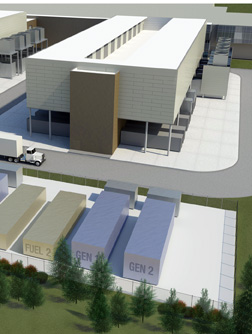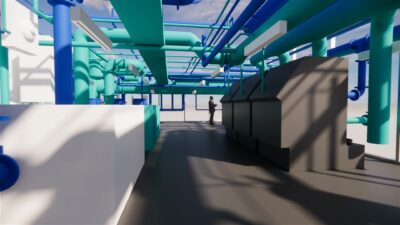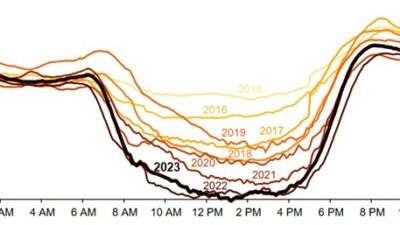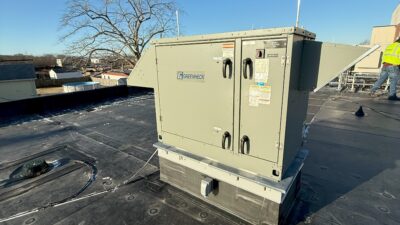The NEC has several categories that apply to generator power sources. It is important to review the code requirements when deciding on the classification of an alternate power source.

The term “emergency generator” is often used mistakenly as a description of any type of generator used to provide power in a facility. However, it is important that the engineer review the code requirements when deciding on the classification of an alternate power source. The NEC has several categories that apply to generator power sources: emergency, legally required standby, and optional standby systems.
A newer classification, critical operations power systems (COPS) was added in the 2008 NEC. These system classifications affect how generators are applied within the distribution system. There are big differences between these types of systems. When communicating with code officials, it is important to use the correct term—emergency or standby—and not mix up the two, unless you have a system with both types of loads.
Several relevant codes and standards have requirements for these classifications:
- NFPA 70 National Electrical Code, Articles 700, 701, 702, 708
- NFPA 99 Health Care Facilities
- NFPA 101 Life Safety Code
- NFPA, 110 Standard for Emergency and Standby Power Systems
- ANSI/IEEE Std 446, Emergency and Standby Power Systems
- UL 1008 Automatic Transfer Switches.
NEC Article 700 classifies emergency systems as “those systems legally required and classified as emergency by municipal, state, federal, or other coded, or by any governmental agency having jurisdiction.” The NEC further states that “these systems … automatically supply illumination, power or both … essential for safety to human life.” In practical terms this normally includes providing power to egress lighting, fire detection and protection, certain types of elevators, public safety communications, or any system where loss of power would cause serious endangerment to life or health within 10 secs of normal power loss.
The NEC also contains requirements for legally required standby systems in Article 701. Code-required standby systems may include communications, selected ventilation or smoke removal systems, lighting, or certain types of industrial processes that may create hazards or hamper firefighting operations if power was not available. The code-required standby systems must be available within 60 secs and may be routed in the same raceway as normal power systems.
Beyond emergency or standby systems, there are two other systems that can be applied as generator power sources. Optional standby systems (Article 702) consist of loads that do not affect life safety but would result in unacceptable financial or operational losses to a facility. Typical loads could include data processing, communication systems, refrigeration, selected HVAC loads, and manufacturing or critical industrial processes. Second, the 2008 version of the NEC added a new section on COPS (Article 708). These are systems, operations, or facilities designated by local, state, or federal government as “mission critical.” Examples can include police or fire stations or other facilities for reasons of public safety, national security, or business continuity. This new section has some notable requirements for engineering practices like commissioning, which have long been practiced in data centers and other previously unclassified “mission critical” facilities.
Loading and generator sizing
Once the loads have been classified into either emergency or standby, we need to examine loading issues such as availability and sizing.
Emergency power is required to be available within 10 secs or less. Standby systems must be available within 60 secs or less, according to the NEC.
In most electrical system sizing, demand or diversity is applied to the electrical loads. However, in both emergency and legally required standby systems the entire load must fully applied, without demand factors. This also includes the starting currents of motors on emergency systems. This is particularly important with loads like fire pumps. Optional standby systems may use load demands calculated using NEC or other methods
It is highly recommend that a generator sizing program be used when calculating loads. Inductive loads, such as motors and transformers, present special concerns with inrush. Transformers, in particular, are overlooked in this regard when being energized by a generator. Electronic or nonlinear loads also present issues with harmonics and voltage regulation. It is not uncommon for data centers to present leading power factor, which presents problems with voltage regulation.
The power factor rating of generators should also be of particular note to engineers. Engine generators are “kW limited,” that is, they are rated using a 0.8 lagging power factor. Therefore, engineers need to focus on using the kW rating as well as the kVA rating of a generator. An additional consideration for sizing is that most engine-driven generator sets are rated for 77 F. You must derate 0.4% for every 10 F above 77 F. Most generator sets are rated for 3300 ft above sea level. You must derate the unit by 1.5% for every 1000 ft above that altitude.
As part of the generator sizing, voltage drop is an issue with emergency or standby generators. Most systems can function with a 20% maximum voltage dip. However, certain systems require less. Examples of voltage drop requirements are shown in Table 1.
|
Examples of voltage drop limits for generator loads |
|
|
System |
Voltage drop |
|
Fire pump controllers |
<15% NEC 695.7 (A) |
|
Elevator controllers |
<15% |
|
UPS systems |
<15% |
|
HID lighting |
<20% |
|
Variable speed drives |
<20% |
Courtesy: Generac
When a single alternate power source, such as a generator, is used to supply both emergency and nonemergency loads, the system must be carefully reviewed. Emergency and nonemergency loads are allowed to be placed on a single generator under certain conditions. Unless the generator has the capacity to handle the full load (including starting currents), load shedding or sequencing must be implemented on the nonessential loads.
Power distribution requirements
Under NEC, emergency circuit wiring must be routed separately from legally required or optional standby circuits (See Figure 2). However, legally required standby circuiting may be combined with optional and other loads.
Emergency generator power distribution systems must also have fire protection when installed in buildings with occupancies of 1000 people or greater, or in certain types of buildings that are taller than 75 ft. This fire protection shall be accomplished by one of two methods:
1. Installing the distribution in spaces protected by sprinklers, or
2. Providing a 2-hour-rated enclosure for the circuit wiring.
The fire protection requirements also apply to the physical feeder circuit equipment itself (panels, transfer switches, etc.), which must be in 2-hour-rated rooms, or rooms with fire protection.
Emergency and legally required standby generator power distribution systems also are required under the NEC to be selectively coordinated. This will require a protective device coordination study, looking at fault levels, and overcurrent devices to ensure that faults are isolated by opening the protective device nearest the fault, allowing the rest of the system to function. Optional standby systems are not required to be selectively coordinated. Another notable protection requirement is that emergency and legally required standby power systems are not to have ground fault protection, but rather ground fault alarms.
Fuel sources and environmental issues
There are typically two fuel choices when considering generators: diesel and natural gas. Natural gas generators are normally used in optional standby systems and with generator less than 300 kW. When considering generators for emergency systems, the possible interruption of a natural gas utility source, and the 10-sec start-up time, normally leads engineers to specify diesel. However, dual-fuel generators may also be considered. The amount of on-site fuel should be sufficient to provide a minimum of 2 hours of run time.
A rough rule of thumb for diesel consumption by a generator is 7 gal/hour for every 100 kW of generator capacity. In many cases where generators used, the desired run times are much longer. It is not unusual to see 8, 24, or even 72 hours of fuel needed for some mission critical facilities. In these cases, the engineer will need to carefully examine where to store the fuel. “Belly tanks” under the generator are common, as are separate fuel tanks. The size of these storage tanks can be very significant, and the use of belly tanks may notably elevate the generator and require catwalks for access. NFPA 110 7.9.5 specifies a maximum of 660 gal diesel storage inside or on the roof of a structure.
The use of generators always requires a careful review of emissions requirements. EPA tier classifications range from T1 to T4, with T4 being the most “clean” type of generator. Local and state requirements will need to be reviewed for any new generator installed at a site. However, in many instances these requirements may be tied to whether the generator is used for emergency or standby uses. EPA defines an emergency generator as operating a maximum of 100 hours per year for testing, during times when the normal source is available. Specifically, the amount of anticipated time the generator will be running per year can affect environmental permitting. Locally based environmental engineers can assist with these code evaluations and permitting at the intended generator site.
Testing
For both emergency and legally required standby generators, testing is required. There are two types of tests to be performed: The first is an acceptance test done upon installation but before becoming operational. A good source for acceptance testing is ANSI/NETA ATS-2009. The second test is operational testing to be performed periodically, subject to the local authority, during the life of the system. NPFA 110-2010 has requirements for testing and maintenance procedures. Written records are to be maintained for either type of system. Of note, emergency systems are required to be tested “under maximum anticipated load” whereas legally required systems are required to be tested “under load.”
As mentioned earlier, generators are also used in COPS defined under Article 708 of the NEC. This section goes beyond the testing required for emergency and legally required standby systems to require commissioning. Commissioning is a common practice in mission critical facilities and includes component, system, baseline, and functional performance tests.
There are notable differences between emergency and standby generators within NEC. The engineer should be careful in using the terms, and understand the requirements, considerations, and specifications when designing generator power systems.
Rener is manager, electrical platform leader and manager of quality assurance with M+W Group, Chicago. He is a member of the Consulting-Specifying Engineer editorial advisory board. This article is dedicated to his late father, Pierre J. Rener, who taught him and many others about effective communication, dedication to one’s profession, and the importance of education and lifelong learning.



